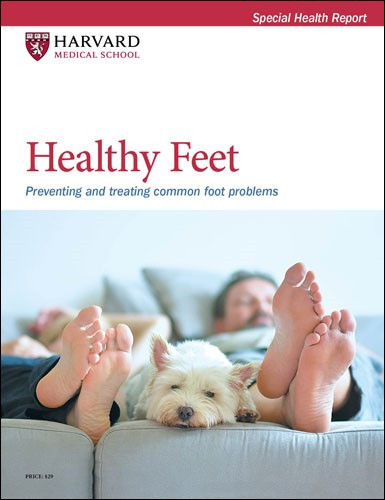Do you really need bunion surgery?
It's a last resort, and you might find relief in other approaches.
- Reviewed by Anthony L. Komaroff, MD, Editor in Chief, Harvard Health Letter; Editorial Advisory Board Member, Harvard Health Publishing
 Bunions are known for being painful, unsightly, and disabling. They can interfere with your ability to walk, exercise, and function. Surgery is one option to treat the condition, but it's not for everyone. "It's worth it if the bunion is painful and stopping you from doing activities. If it isn't, don't jump into the procedure without carefully weighing the risks and benefits," says Dr. Gregory Waryasz, a foot and ankle surgeon with Harvard-affiliated Mass General Brigham Sports Medicine.
Bunions are known for being painful, unsightly, and disabling. They can interfere with your ability to walk, exercise, and function. Surgery is one option to treat the condition, but it's not for everyone. "It's worth it if the bunion is painful and stopping you from doing activities. If it isn't, don't jump into the procedure without carefully weighing the risks and benefits," says Dr. Gregory Waryasz, a foot and ankle surgeon with Harvard-affiliated Mass General Brigham Sports Medicine.
A misaligned joint
Your bunion isn't just a bony lump on the side of your foot; it's a misaligned metatarsophalangeal (MTP) joint. The MTP connects the first long bone (metatarsal) in the forefoot to the first bone of the big toe (phalanx).
Sometimes the ligaments holding those bones in a straight position weaken, causing the first metatarsal bone to jut outward. The phalanx bone then shifts to point outward as well, and you're stuck with an angled deformity that breeds more trouble. Potential problems include
- bone pain (at the bunion)
- a chronic skin sore (ulcer) on the bunion as it rubs against your shoe
- pain in the second toe (as the big toe pushes against it)
- dislocation of the second toe (as it's forced upward by the big toe).
The official fix
Don't believe marketing promises about gadgets promising to realign the bones; there's no solid evidence to support the claims. The only way to get rid of a bunion is with surgery, and there are numerous types and approaches. Dr. Waryasz says the following procedures are most common.
Osteotomy. This is often performed for moderate bunions. It involves cutting apart and realigning the bones of the MTP joint, then fixing them in place with surgical screws. An osteotomy can be done with large incisions (traditional open surgery) or small incisions (minimally invasive surgery).
Lapidus procedure. In this surgery for severe bunions, the surgeon realigns the bones and fuses them together permanently at a specific spot in the midfoot. A Lapidus procedure can be done with either traditional or minimally invasive surgery.
Arthrodesis. This surgery is helpful when there's arthritis in the MTP joint. It also involves realigning the MTP joint bones and fusing them together to eliminate movement, but at a different spot than a Lapidus procedure. An arthrodesis is typically performed through traditional open surgery, but can be done with minimally invasive surgery.
Is surgery the right move?
Dr. Waryasz says surgery is usually warranted when bunion pain becomes disabling, if there is a skin ulcer, or if it's necessary to prevent the second toe from dislocating. Surgery can fix all of that and get you back to doing the activities you love. But you'll want to consider the following factors, too.
Pain. Bunion surgery causes pain. Usually, the pain is gone within six weeks, but for some people it lasts months to years.
Cost. Medicare Part B pays for 80% of the cost of medically necessary bunion surgery (which ranges from $5,000 to $12,000).
Recovery. You'll have to keep weight off the affected foot for two to six weeks, depending on the procedure, and wear a postsurgical boot for another month or two. You'll also need physical therapy. This is something to consider if you travel a lot.
Complications. The surgery has a low risk of complications, but they can happen. "Sometimes bone fusions don't heal properly, and we need to redo the surgery. Or the screws in the bone might bother you. Or you might have nerve injury or infection," Dr. Waryasz says.
Recurrence. Recurrence rates are less than 20% for the three types of approaches mentioned in this article.
Questions to ask your surgeon before you get bunion surgery
|
Temporary fixes
If you're not ready for bunion surgery, several strategies can help prevent or relieve bunion pain.
Add cushioning. Place an adhesive cushion in your shoe where it rubs against the bunion. Cushions are often made of moleskin fabric or a gel-filled material.
Stretch your shoes. Use a stretching device ($20 and up) to widen your shoes where the bunion sticks out, or have a cobbler do it for you. The extra space will make the shoes more comfortable and reduce pain and irritation.
Try a shoe trend. "We're seeing an increase in shoes that are wider at the toes or made of stretchy fabrics, which is helpful for people with bunions," Dr. Waryasz says. "Just make sure the shoes have a sturdy area around the heel to keep your foot in place, and a wide, flexible sole to support your foot."
Use a spacer. Spacers separate the big and second toes, providing pain relief. Spacers come in many forms, such as a molded foam or silicone wedge that's inserted in between the toes, or a silicone sleeve with little tubes for the toes (like a glove). Prices start at about $10.
Dr. Waryasz says these approaches might be all you need to live with a bunion for the rest of your life. "Use them regularly. Follow shoe innovations online, or become best friends with the shoe store person," he says. "If your bunion doesn't really bother you, avoid surgery. It should always be a last resort."
Image: © sittithat tangwitthayaphum/Getty Images
About the Author

Heidi Godman, Executive Editor, Harvard Health Letter
About the Reviewer

Anthony L. Komaroff, MD, Editor in Chief, Harvard Health Letter; Editorial Advisory Board Member, Harvard Health Publishing
Disclaimer:
As a service to our readers, Harvard Health Publishing provides access to our library of archived content. Please note the date of last review or update on all articles.
No content on this site, regardless of date, should ever be used as a substitute for direct medical advice from your doctor or other qualified clinician.
















